Tag: Main Street Report
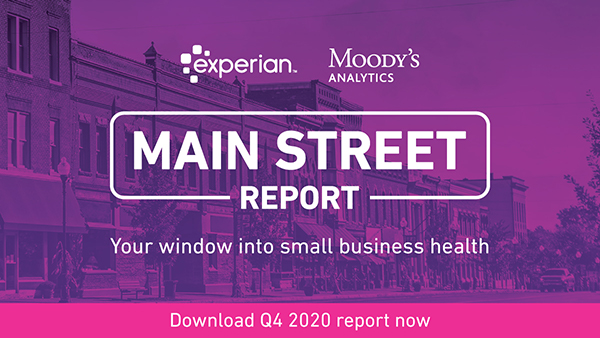
Experian and Moody's Analytics have just released the Q4 2020 Main Street Report. The report brings deep insight into the overall financial well-being of the small-business landscape and offers commentary on business credit trends and what they mean for lenders and small businesses. Small businesses increased hiring during the holiday season, offsetting some of the pandemic's job losses. Many of these jobs were funded by credit while companies paid down outstanding debt. This trend of paying down debt caused moderately delinquent balances to decline to 1.21 percent from 1.60 percent during the same time last year. There has yet to be a decisive upturn in delinquency and bankruptcy, as would be expected following the pandemic lockdowns of the previous year. With a change in administration, small businesses are feeling concerned about taxes, as noted in recent NFIB surveys. But these growing concerns did not dampen borrowing or hiring during the fourth quarter. Business Chat Live Watch the replay of our interview with Cristian DeRitis from Moody's Analytics and Brodie Oldham. Join us for the Q4 Quarterly Business Credit Review You can also save your seat for our upcoming Quarterly Business Credit Review webinar for a deep dive on the latest report. Date: Tuesday, March 16th, 2021 Time: 10 a.m. (Pacific) | 1:00 p.m. (Eastern) Save My Seat
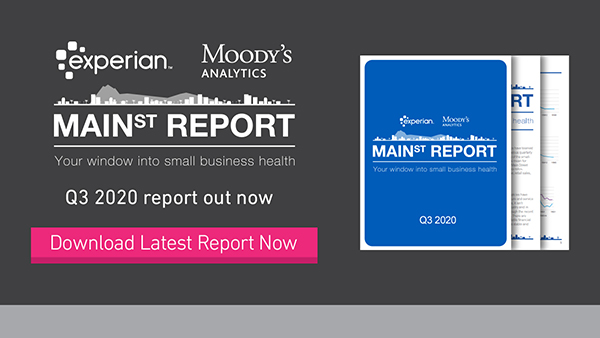
Experian and Moody's Analytics have just released the Q3 2020 Main Street Report. The report brings deep insight into the overall financial well-being of the small-business landscape, as well as offer... Experian and Moody's Analytics have just released the Q3 2020 Main Street Report. The report brings deep insight into the overall financial well-being of the small-business landscape, as well as offer commentary on business credit trends and what they mean for lenders and small businesses. In a fight for survival, small businesses have turned to layoffs and borrowing as they attempt to reach the other side of COVID-19. The increased borrowing is helping to mask rising late-stage delinquencies and bankruptcy. But these tactics can only mask weakness for so long. With another round of government stimulus unlikely to arrive before year's end, small businesses will need to borrow for survival again. While we did see some jobs come back in Q3, small business payrolls have shrunk by more than 2 million from this time last year. The hardest hit are those businesses with 1-19 and 20-49 employees; both of these groups saw payrolls shrink by 1 million employees. The 31-90 days past due (DPD) delinquency rate on small business credit plunged to 1.25 percent in the third quarter. This ended the streak of increasing delinquency we had observed for the last year. However, this is likely to be short-lived, as the US appears to have entered a new phase of the COVID-19 pandemic with cases again on the rise. Commercial and Industrial loans continued to run hot. C&I numbers are a lagging indicator, so the latest numbers reflect the second quarter. At that time new C&I lending was 21 percent higher than in the same period a year ago. If you would like to get the full analysis of the data behind the latest Main Street Report, join us for the Quarterly Business Credit Review webinar.
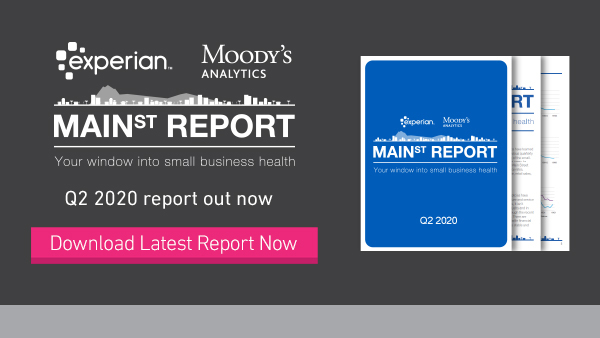
Experian and Moody's Analytics have just released the Q2 2020 Main Street Report. The report brings deep insight into the overall financial well-being of the small-business landscape, as well as offer commentary on business credit trends, and what they mean for lenders and small-businesses. Small businesses have turned to borrowing to survive periods of prolonged slumping sales, in many cases from government programs offering loan forgiveness. This increased borrowing has masked rising delinquent balances, but such a solution is a short-term fix. To keep their credit current, small businesses will need to find ways to generate revenue. Defaults are expected to rise in coming quarters as forbearance programs expire and as customers are likely to change their priorities in the wake of COVID-19. In Q2, moderate delinquency, defined as 31-90 days past due, rose to 1.66 percent from 1.61 percent, marking the fourth consecutive quarter of increasing delinquency, and the first year-over-year increase since this time last year. The closure of many state and local economies in April and the first half of May left many businesses facing severe revenue shortfalls in the second quarter. This environment has resulted in businesses listing poor sales as the second most important problem facing small businesses, according to the NFIB. If you would like to get the full analysis of the data behind the latest Main Street Report, presented by leading economists from Moody's Analytics and Experian, watch the Quarterly Business Credit Review webinar.
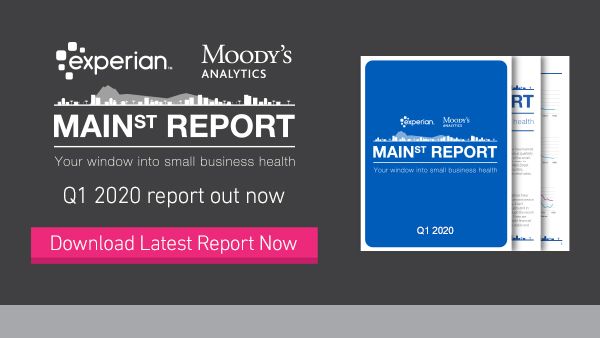
Experian and Moody's Analytics have just released the Q1 2020 Main Street Report. The report brings deep insight into the overall financial well-being of the small-business landscape, as well as offer commentary on business credit trends, and what they mean for lenders and small-businesses. After just one quarter, there’s no doubt the theme of 2020 is the pandemic, Covid-19. Unrelated to the pandemic, and subsequent shuttering of a swath of economies across the world, delinquencies rose in the first quarter. This was occurring as businesses reduced their borrowing. Lower borrowing will not have lasted long though, as government efforts to aid small business have taken the form of SBA lending. In Q1, the slowing of businesses pursuing credit pushed moderately delinquent balances up to 1.61 percent from 1.60 percent in the fourth quarter of 2019. # DPD Q1 19 Q4 19 Q1 20 Moderately delinquent 31–90 1.74% 1.60% 1.61% Severely delinquent 91+ 3.35% 2.29% 2.68% Bankruptcy 0.16% 0.16% 0.16% The bankruptcy rate was essentially flat in the first quarter, rising to 16.3 basis points from 16.1 in Q4. But the rate increased as fewer firms were reported as having active credit balances. The Federal Reserve’s Senior Loan Officer Survey indicates lenders are seeing higher demand than usual for Commercial & Industrial loans. This indicates the beginning of increasing loan demand this year, as small firms look to borrow to ride out lower consumer demand and remain in business. Watch the Quarterly Business Credit Review Get the full analysis of the data behind the Main Street Report by watching the experts from Experian and Moody’s in the Quarterly Business Credit Review.
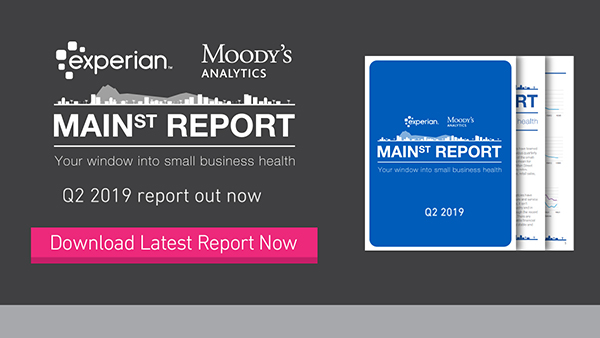
Experian and Moody’s Analytics have just released the Q2 2019 Main Street Report. The report brings deep insight into the overall financial well-being of the small-business landscape, as well as providing commentary on what certain trends mean for lenders and small businesses. Q2 Highlights In spite of business confidence in the second quarter, shaken by talk of trade war escalation, small businesses got a helping hand from seasonal factors that combined to push delinquency rates down. Delinquency rates for businesses with fewer than 100 employees fell in the second quarter, decreasing the 31–90 days past due rate from 1.74 percent to 1.64 percent for the quarter. But agriculture’s problems continued as weather and trade conditions continued to weigh on small farms. These factors won’t be as helpful in the third quarter, so fundamentals or confidence will need to improve to propel performance and growth forward. Bankruptcies ticked up ever so slightly again in the second quarter coming in at over 16 basis points. The most recent data available, from Q4 2018, indicates an establishment growth rate of 2.3%. Enough of these new businesses will seek credit to ensure that, combined with existing borrowers, balances look set to grow for some time. Overall, small businesses continue to display little to no signs of broad-based weakness. What weakness exists is fairly well confined at either the regional or industry level, and the solid performance that has been the norm for the last several quarters looks set to continue. Watch Webinar Recording Experian and Moody's Analytics go in-depth on the Q2 2019 Main Street Report in the below webinar.
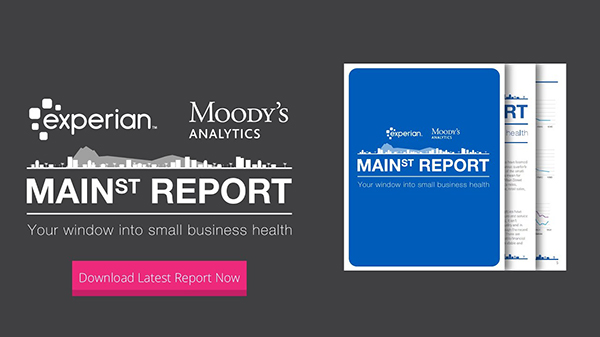
Experian and Moody’s Analytics have just released the Q1 2019 Main Street Report. The report brings deep insight into the overall financial well-being of the small-business landscape, as well as providing commentary on what certain trends mean for lenders and small businesses. In Q1 U.S. small businesses brushed off a government shutdown as stock markets recovered and income gains remained steady. Delinquency rates remained mostly stable, with pockets of weakness spread out among regions and industries, notably agriculture in the Great Lakes and manufacturing in the Southwest. Small firms seem to have simply shrugged off the headwinds of the first quarter and kept on with business as usual. Despite a fresh escalation in trade tensions, the year is starting off well with positive news coming from the areas presenting risks to the outlook. A dovish stance on interest rates from the Federal Reserve and room to grow in our housing market — 2019 is off to a strong start. Watch Webinar Recording - Q1 2019 Quarterly Business Credit Review Listen to the experts from Experian and Moody's Analytics go in-depth on insights revealed in the Q1 2019 Experian/Moody's Analytics Main Street Report.
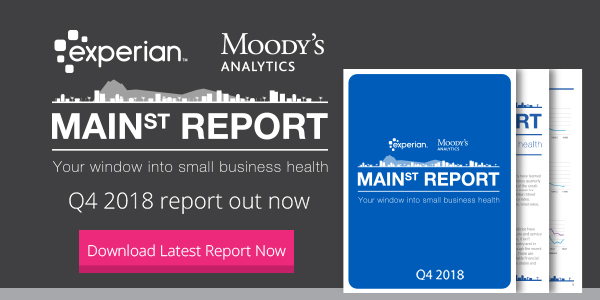
Experian has released the Experian/Moody's Analytics Main Street Report for Q4 2018. The report brings deep insight into the overall financial well-being of the small-business landscape, as well as providing commentary around what certain trends mean for credit grantors and the small-business community. Bucket 17Q4 18Q3 18Q4 Moderately Delinquent 31-90 1.68% 1.63% 1.68% Severely Delinquent 91+ 4.00% 3.40% 3.49% Bankruptcy BKC 0.16% 0.16% 0.16% The fourth quarter capped a second year of solid performance and growth for small-business credit, but there are signs that the period of moderation experienced during the past two years is over. Since the government shutdown has the potential to throw small-business lending a curve ball in the first half of 2019, the outlook for small-business credit is neutral. Conditions were positive in the fourth quarter, but this may not last long. Delinquency rates remained mostly stable, with pockets of weakness spread out among regions and industries, notably construction in the Plains. In addition to the 35-day shutdown, rising interest rates, destabilizing trade policy and slowing home-price growth are potential trouble sources that are already starting to impact some regions.
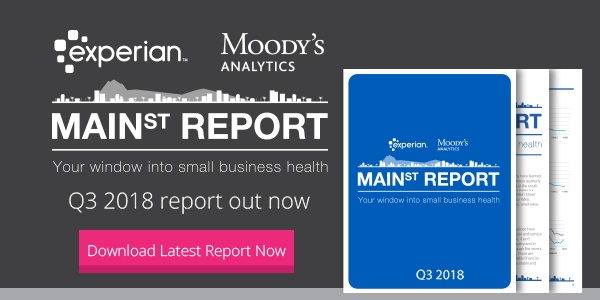
Today Experian and Moody's Analytics released the Q3 2018 Main Street Report. The report brings deep insight into the overall financial well-being of the small-business landscape, as well as providing commentary around what certain trends mean for credit grantors and the small-business community. For Q3 2018, the overall outlook for small-business credit is positive, but some industries such as construction have a negative outlook. Delinquency rates stable for now Delinquency rates are stable around their current levels, but this could change quickly if risks mount for certain industries. Continuing strength in the economy should keep small-business credit performance in check through the fourth quarter and early next year. Rising interest rates, destabilizing trade policy and slowing home-price growth are potential sources of trouble that are already starting to impact some regions. To bring insight to these Q3 business credit findings, Experian and Moody's Analytics will be presenting the Quarterly Business Credit Review for Q3 2018 on Tuesday, December 11th 10:00 a.m. (Pacific) 1:00 p.m. (Eastern). Read the report and bring your questions, we will be opening up the session for live Q&A as we dig into the numbers and the outlook for Q4 2018. We hope to see you there. Presenters: Gavin Harding Derrek G. McCrank Cristian deRitis
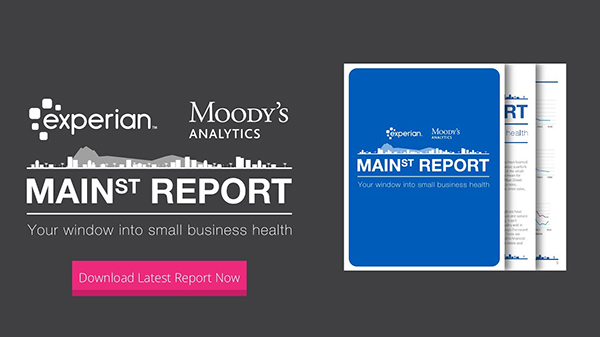
Today Experian Business Information Services releases the Experian/Moody's Analytics Main Street Report for Q1 2018. The report brings deep insight into the overall financial well-being of the small-business landscape, as well as providing commentary around what certain trends mean for credit grantors and the small-business community. Q1 2018 saw credit conditions loosening and balances rising as more businesses access credit. The report states the overall outlook for small-business credit is positive. Delinquencies were down and default rates rose slightly, suggesting that credit conditions have peaked as the economy is in a late-cycle expansion. Continuing strength in the macroeconomy will keep small-business credit moving in the near term, along with higher profits from the recently passed tax legislation. Small-business credit will be less certain in the medium to long term as rising wages, interest rates and changes to the tax code take a toll. Download the latest report
